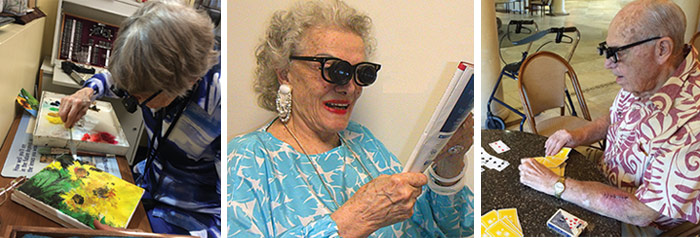
By Richard Shuldiner, OD, FAAO, President, IALVS
Low vision prescription glasses, which combine magnification with the patients’ farsighted, nearsighted and/or astigmatic corrections, are the most misunderstood and underutilized visual aids for central vision loss patients.
This is unfortunate because most patients prefer the hands free and optically superior benefits instead of over-the-counter handheld and electronic devices. Essentially, most people function better and are more comfortable with glasses.
Low vision prescription glasses come in various types and levels of magnifications. They are custom designed and fabricated according to the patient’s needs. The benefits of hands-free glasses are numerous, allowing efficient continuous reading, two-handed craftwork, and far distance viewing and even driving.
Telescopic glasses can be useful for most activities such as driving, playing bridge, watching television, spectator sports, theater, reading, sewing and many other tasks. Bioptic Telescopic glasses allow the user to have both a magnified and a normal view. Moving from one field to the other at will, the patient can read traffic signs when driving. They are legal in almost every state. Full diameter telescopic glasses offer a magnified field for watching television and seeing faces and can be adapted for reading at various distances.
While hand and stand magnifiers are very useful for near spotting like seeing a price tag or label, they are very cumbersome for continuous reading. Reading one or two words at a time with a magnifier discourages reading, which leads to the loss of reading ability. Low vision microscope and prismatic glasses allow for hands-free continuous reading and should be prescribed early on to prevent loss of reading ability. In fact, if a person with central vision loss can read with a hand magnifier, they can read with low vision glasses.
E-Scoop and the new LPTS (low power telescope spectacles) offer small amounts of magnification and glare control for safer mobility. The E-Scoop lenses, developed recently in Holland, offer a “regular” glasses look by combining a slightly thicker and more curved lens with special coatings and tints. They provide 3 to 6 percent magnification, improving contrast and sharpness while allowing mobility. They have the ability to eliminate oncoming headlight glare when driving at night. The new LPTS glasses offer 9 to 17 percent magnification.
Side Vision Awareness Glasses and reverse telescopic glasses can improve function in people with visual field loss. Those with traumatic brain injury, advanced glaucoma and other field reducing conditions can be helped to move around their environment more safely.
Because low vision prescription glasses are custom designed and fabricated, their cost may be higher than OTC handheld optical devices.
April 2017
Eyes/Optics













